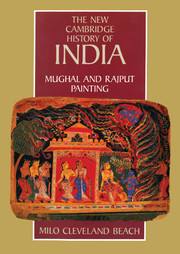Book contents
- Frontmatter
- Introduction
- 1 Painting in North India before 1540
- 2 1540–1580: Painting at Muslim courts
- 3 1580–1600: The new imperial style and its impact
- 4 1600–1660: Mughal painting and the rise of local workshops
- 5 1660–1700: The growth of local styles
- 6 1700–1800: The Dominance of Rajput Painting
- 7 1800–1858: Traditionalism and new influences
- Appendix
- Bibliographical essay
- Index
- The New Cambridge History of India
- References
7 - 1800–1858: Traditionalism and new influences
Published online by Cambridge University Press: 28 March 2008
- Frontmatter
- Introduction
- 1 Painting in North India before 1540
- 2 1540–1580: Painting at Muslim courts
- 3 1580–1600: The new imperial style and its impact
- 4 1600–1660: Mughal painting and the rise of local workshops
- 5 1660–1700: The growth of local styles
- 6 1700–1800: The Dominance of Rajput Painting
- 7 1800–1858: Traditionalism and new influences
- Appendix
- Bibliographical essay
- Index
- The New Cambridge History of India
- References
Summary
Whether we are dealing with imperial Mughal paintings during Jahangir’s reign, the Rajput style at Jodhpur, or pahari traditions, periods of innovation are followed by the resurgence of conservative, continually valid, pan-Indian artistic values. Two paintings from the pahari region are especially useful in defining these values. In Raja Sansar Chand of Kangra with His Small Son and Courtiers (fig. 166), the architectural setting and the arrangement of the people derive directly from Raja Balwant Singh Performing his Toilet Before Retiring (plate N), painted by Nainsukh more than half a century earlier, and the Mughal Muhammad Shah with Courtiers (plate O). The painting could not have been executed without these prototypes. Nonetheless, the dancing women and the foreground soldiers – hierarchically less important figures – are very much smaller in scale than the courtiers, and they in turn are dominated by the massive raja. As in the allegorical portraits of Jahangir which changed the direction of Mughal painting about 1615, we have been transferred back to a world of symbolism and hierarchy.
Arjuna and His Charioteer Lord Krishna Confront Karna (fig. 167) is in an even more conservative style. Like The Departure of Damayanti for Nisadha (fig. 157), this depicts an episode described in the Mahabharata. However, the earlier work placed the gods firmly on earth, inhabiting palaces and courtyards in which the patrons of the paintings would themselves have felt comfortable. The only space in the scene of Arjuna and Krishna, however, is flat on the surface; the confrontation is expressed through strong, formal surface patterns, flat shapes, and proportions based even more obviously on hierarchy rather than nature.
- Type
- Chapter
- Information
- Mughal and Rajput Painting , pp. 214 - 228Publisher: Cambridge University PressPrint publication year: 1992



